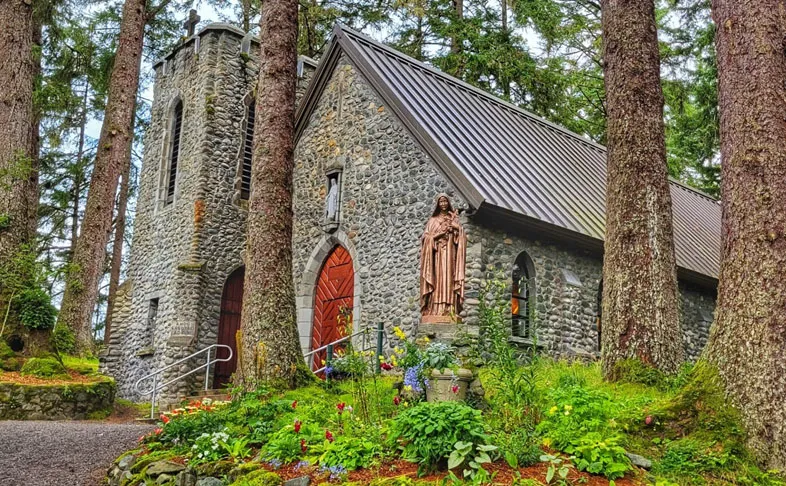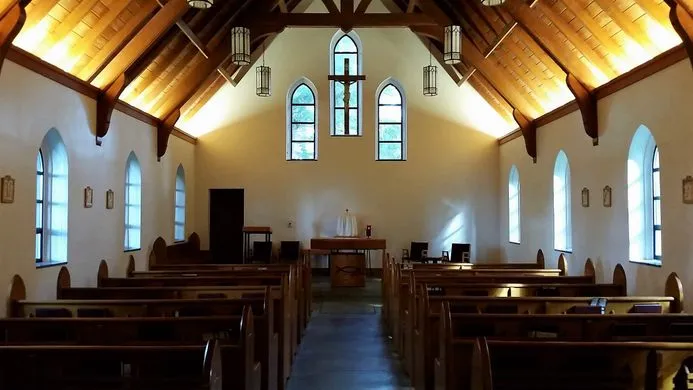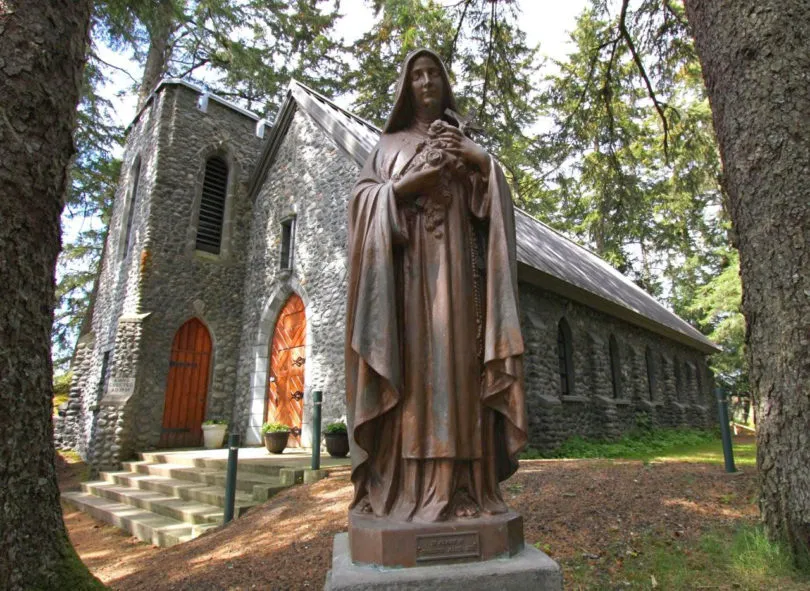
Introduction
The National Shrine of St. Thérèse began as the dream of Fr. William G. LeVasseur, S.J. (Society of Jesus, or the Jesuits). Fr. LeVasseur saw the need for a retreat center in Alaska. He approached Bishop Crimont, the first Bishop of Alaska, and asked for permission to build the retreat center.
Bishop Crimont had a deep devotion to St. Therese and knew members of her family. He wanted the retreat center to be dedicated to St. Therese. originally began as a small chapel in the 1920s, but over time, it grew in size and popularity. It was named after St. Therese of Lisieux, a French nun, who is known as the “Little Flower.”
The shrine has since become a center of worship and pilgrimage for Catholics, and it has undergone several renovations and expansions throughout the years. The shrine also played a significant role in providing spiritual guidance and comfort to soldiers during World War II. Today, it remains a cherished landmark and a testament to the enduring power of faith and devotion.
In fact this shrine has an architectural style and design that will blow your mind. From the carefully selected materials and techniques used, to the symbolism infused in every nook and cranny, this place is a masterclass in architectural brilliance.
The National Shrine of Saint Thérèse of Lisieux in Juneau, Alaska is the result of people coming together to create something greater than themselves. It is a pioneering story that reflects the Christian journey of seeking God. The shrine, which includes a retreat house and chapel, was the dream of Father William G. Levasseur. He recognized the need for a place that would inspire greater devotion to God and provide a retreat house to bring people closer to the source of life.
The shrine is dedicated to Saint Thérèse, known as “the little flower of Jesus,” who had a profound devotion to God and believed in the power of love in everyday life. The construction of the shrine faced challenges due to limited funds and skilled workers, but through the support of the community and the dedication of individuals, the retreat house and chapel were completed.
The shrine has continued to evolve over the years with the addition of facilities such as the columbarium, the rosary walk, the jubilee cabin, the little flower cabin, and the merciful love labyrinth. Despite periods of closure and restoration, the shrine remains a place of spiritual significance and renewal. In 2016, the United States Conference of Catholic Bishops designated the Shrine of Saint Thérèse a national shrine.
Thérèse Martin, otherwise known as Thérèse of Lisieux, was born in France in 1873. She became a cloistered nun of the Carmelite Order at the age of 15. She died nine years later at the age of 24. She was canonized a saint in 1925. In the Catholic tradition, we honor and imitate saints like St. Thérèse, just as we would anyone we love and who has outstanding characteristics. Saints, like St. Thérèse, are never worshiped. Rather we ask them to pray with us and for us as we might ask someone here on earth for prayers of support.
Thérèse is known for her “little way”. In her autobiography, The Story of a Soul, she wrote that what really mattered in life was not our great deeds, but our great love. She believed that the God of mercy had a special love for “ordinary” people, including herself. Through personal example and unshakable confidence in God’s love, St. Thérèse put into practice her belief that opportunities for loving occur most often in the ordinary events of one’s life, and through these happenings we are called to choose to love others with God’s help, and to grow into wholeness and holiness. The message of St. Thérèse, now known throughout the world, teaches us that no one has to earn God’s love. God loves us first and the purpose of life is to respond to this love.
Architecture and Design of National Shrine of Therese

The National Shrine of Therese is a perfect blend of classic and modern architectural styles. The designers were definitely thinking outside the box when they created this masterpiece. From soaring arches to intricate details, every inch of this place screams sophistication. You’ll feel like you’ve walked right into a historical fantasy novel.
Marble, stained glass, and exquisite woodwork are just a few of the elements that make up the shrine. It’s like a symphony of textures and colors, all harmoniously coming together. The symbolism in the design will make your head spin. Every nook and cranny has a hidden meaning waiting to be discovered. From intricate mosaics representing the circle of life to statues that tell ancient myths, you’ll find yourself lost in a world of symbols and metaphors.
Certainly! The National Shrine of Therese is not just a place of religious significance, but also a testament to fine architecture and design. Its evolution over the years has given it a unique blend of modern and classic styles. The shrine’s exterior is impressive, with grand arches, intricate details, and awe-inspiring sculptures that evoke the grandeur of classic Gothic architecture.
Inside, the shrine boasts a more modern yet still striking style, with intricate mosaics, elegant stained-glass windows, and stunning marble sculptures. Every corner of the shrine is a work of art that adds to the serene atmosphere of the entire place. Overall, the architecture and design of the National Shrine of Therese is a true marvel that deserves to be seen and appreciated by architecture enthusiasts and art lovers alike.
The National Shrine of Therese is a magnificent place that boasts of awe-inspiring architecture. The highlights that one must see include the exquisite sculptures and statues that grace the shrine. The intricate detailing on religious figures and the magnificent depictions of saints are truly remarkable. Moreover, the stunning paintings and frescoes that adorn the walls of the shrine are a must-see. The attention to detail, the brushstrokes, and the colors used in these masterpieces are remarkable. Additionally, the delicate woodwork and ornate stained glass windows serve as other highlights that add charm and beauty to this enchanting shrine.
Shrine Chapel

Although originally intended to be a log church, the Chapel, constructed of Shrine-site beach stone, was built in the late 1930’s. Fr. William LeVasseur, a Jesuit priest from New Brunswick, Canada had the idea and vision to create a retreat center in Alaska. Bishop Joseph Raphael Crimont, S.J., the first bishop of Alaska, gave his consent and blessing to the establishment of the Shrine of St. Therese.
The inaugural Mass was celebrated in the Chapel on the Feast of Christ the King, October 26, 1941. As a lasting memorial, following his death in 1945, Bishop Crimont was buried in a crypt under the Chapel altar area. In May of 1988, after nearly 50 years without a bell, one was installed in the tower and named “Raphael”, (Bishop Crimont’s middle name), which means “God Heals”.
Stations Of The Cross
The stone structures sheltering scenes of Christ’s final hours of human life are part of a Catholic tradition of devotion called the Stations of the Cross (or Way of the Cross). Each of the Stations describes a scene from the passion, death, or resurrection of Jesus Christ.
The Station rock structures were built about 1940. However, new sculptures were created by the artist R.D. Robinson and installed April, 1989. Cast in cultured alabaster, the scenes are meant to speak to people personally as they journey with Christ from station to station.
Good Shepherd Rosary Trail
Located just across Shrine Creek is a walking path called the Good Shepherd Rosary Trail which is wheelchair navigable. This path begins with a bronze plaque of the Good Shepherd, Jesus Christ, who reaches out and cares especially for those who are less fortunate in the “eyes of the world”.
As a remembrance to the late Bishop Michael Kenny of the Juneau Diocese, this trail is dedicated to him, for he represented the Good Shepherd in many ways, particularly in his respect for life from conception to death.
As one walks this trail, you will come upon four semi-circled areas, each one containing five bronze plaques of the Rosary. The first area represents the Joyful Mysteries, the second are the Sorrowful Mysteries, the third are the Glorious Mysteries, and the fourth are the Luminous Mysteries. The present form of the Rosary was established in the Middle Ages, after the Hail Mary became popular.
The Luminous Mysteries were added by St. Pope John Paul II during the Jubilee Year of 2000 which meditate on the Ministry of Christ. The name “rosary” indicates a garland of roses. Linked together in a systematic way, the Rosary beads symbolize a crown of roses. The rosary is scripturally based, Christ-centered and is a rich devotional source of prayer for many Catholics and non-Catholics alike.
Pieta Statue
At the end of the Good Shepherd Rosary Trail is a replica of Michelangelo’s famous statue “The Pieta.” The statue depicts the Blessed Virgin Mary cradling in her arms the body of her beloved son, Jesus, after he was removed from the Cross.
Merciful Love Labyrinth

The Merciful Love Labyrinth was constructed in the spring of 2001. Just as the Chapel builders had done in the 1930’s to provide rocks for the Shrine Chapel, Stations of the Cross and other building foundations as a labor of love, volunteers of all ages carried stones from the beach nearby for constructing the Merciful Love Labyrinth.
Labyrinths, symbols of the single path to the sacred center, have no confusing dead ends or false pathways; mazes, on the other hand, have many paths, purposely designed to confuse and dupe the person navigating them. As Janis Burns Buyarski shares, “Labyrinths are part of the mystical tradition which looks for a direct connection to the Divine. It is a part of the ‘kinetic knowing’, of praying through moving the body…In a time when many people are seeking ways to integrate psychology with spirituality, the labyrinth creates a safe, open space where the inner and outer meet and become one… Labyrinths are symbols of the path to the sacred center, and a metaphor for the human journey of life”.
Captivating Stories
Rumor has it that Saint Therese herself has been known to make appearances in the dreams of visitors, offering them guidance and solace. Some even claim to have witnessed her ghostly figure gliding through the halls, bringing comfort to those in need. Spooky, right?
Now, let me share some fascinating anecdotes and interesting facts about this awe-inspiring place. Legend has it that a famous sculptor once chiseled a statue of Saint Therese, pouring his heart and soul into the artwork. Word on the street is that the statue shed tears of joy when it was unveiled, leaving everyone in awe.
But it’s not just the legends and anecdotes that make this shrine special. The personal experiences of the visitors lend an air of authenticity and wonder to the place. People have reported feeling a sense of peace and serenity wash over them as soon as they step foot inside. It’s as if all the worries and troubles of the outside world simply melt away.
Feast Day
Annual feast day of National Shrine of Therese is celebrated on 1st October.
Mass Timing
Weekdays
- 11.30 am
Contact Info
21425 Glacier Hwy, Juneau, AK 99801,
United States
Phone No.
Fax: (907) 463-3237
Accommodations
How to reach the Sanctuary
Airway
Juneau International Airport is the nearest Airport which is 14.3 mi (23 mins) from the Shrine
Railway
Alaska railroad depot is the nearest rail station to the shrine.







